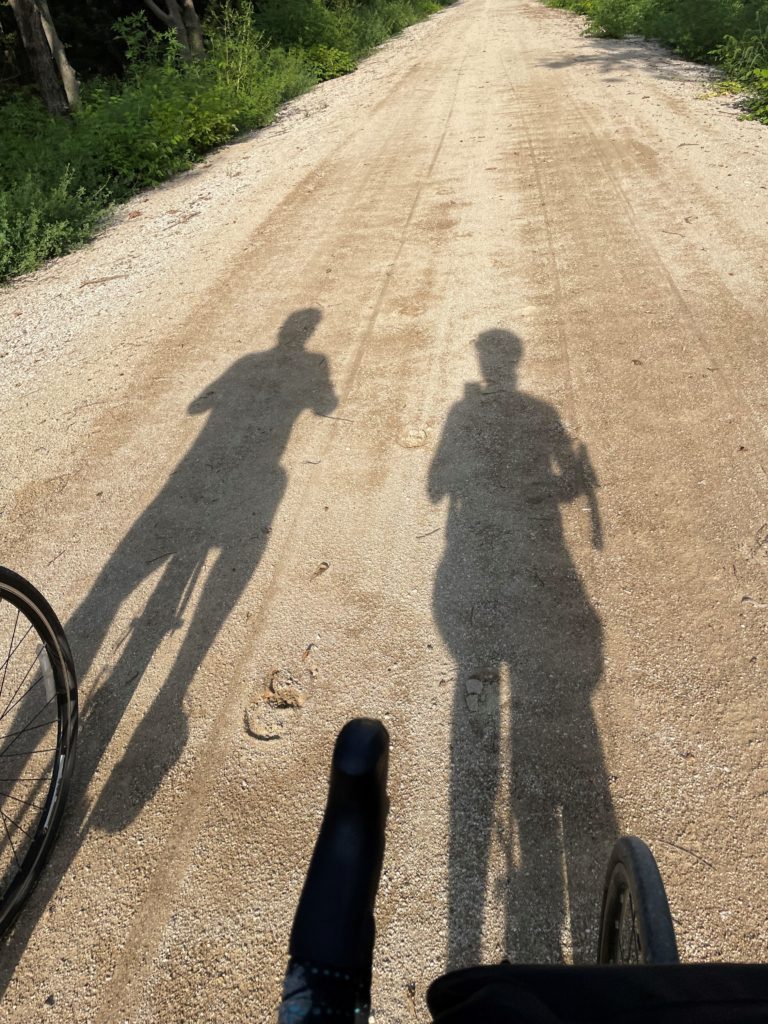Our quest to ride in every state in America landed us in Vassar, Kansas, a one-horse town about 30 miles south of Topeka, at a trailhead for the Flint Hills Nature Trail. Thankfully, we’d read that it was near a grain silo, otherwise, we might have missed the small dirt clearing we used as a parking lot.
The seventh longest rail-trail in America, the Flint Hills Trail stretches 117 miles across eastern Kansas on what used to be the Missouri Pacific Railroad. Today, it is a crushed stone path with occasional pieces of shale and deeply rutted soft dirt that, at one point, caught one of Kellie’s tires and caused her to careen into Jim. The riding was slow and bumpy the first several miles and we kept a tight grip on our handlebars.

The trail was straight as an arrow and flat as a pancake, although the rolling Flint Hills surrounded us. Billed as one of the last remaining tallgrass prairie ecosystems, the topography was not what we had expected – it was greener and hillier and we didn’t see any particularly tall grass. We’d read that there were turkeys and bobcats in the area, the latter of which we may have seen earlier in the day when what we thought was a large, healthy fox darted across the highway. (This got us to wondering: is a bobcat one of the animals that, if encountered, you’re supposed to make yourself look bigger or avoid eye contact?)
Actually, the only wildlife we encountered while biking were very loud flying insects that reminded us of the cicadas that plague the mid-Atlantic every 17 years.
The trail was lined with scrubby cedars and other trees that formed a narrow screen between us and the farmland on either side. These provided some shade on what otherwise would have been a scorching ride in the summer sun. We saw a few large irrigation ponds, some small farms and a herd of 40 or so cattle crowded beneath the shade of a single tree.
About every mile, we passed through a gateway with a post on either side, that looked, from a distance, like approaching figures. In fact, we only passed one other bike and two pedestrians during our two-hour ride.


As city folk, we find riding among corn, soy and wheat fields to be both peaceful and humbling. We know so pitifully little about agriculture! Why is some hay bailed and some rolled? Why are there random stalks of “volunteer” corn popping up in the soy fields? What is “milo”? (We had to look it up: it’s a cheap alternative to corn that is fed to livestock, for you other urban ignoramuses.) Kellie is fascinated by farming and would have liked to have had an agricultural tour guide bike along with us.
The trail widened and improved after we passed through a gateway onto a very broad two-lane roadway with well-packed dirt and cinder. Here we recognized hoof marks along with the smell of either horse manure or an actual dead horse. (Kellie is very sensitive to unpleasant smells – don’t get her started about our three-day bike tour around Lake Champlain in Vermont, or as she calls it, “The Cow Crap Capital of America.” She wanted to have her nose sutured closed. Clearly, her love of farming has its limits.)

The sun was setting as we arrived back at our car and made our way toward Blind Tiger Brewery, housed in an old stone and wood restaurant on the outskirts of Topeka. After the long, hot ride, we eagerly grabbed a table on the outside deck and went to work trying their award-winning brews.
Kellie ordered a flight that included a Raw Wheat Ale (which was slightly hazy), a Raspberry Sour (which was delicious), an Apricot Wheat that had a more distinct apricot taste than many others she’d tried, and a wheat with Oregon raspberries called Cuvee de Rene after the brewmaster’s wife.
Jim had their Ohio Hazy IPA and Tiger Bite IPA (which, at 60 IBUs, he preferred to the former).

Please share anything more you know about the Flint Hills Trail or breweries nearby in the Comments section below.

